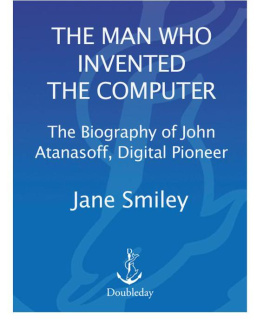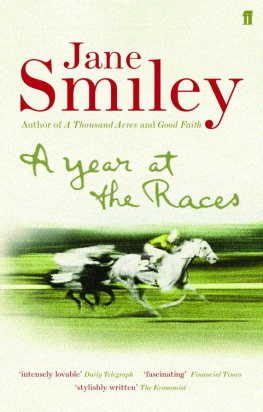Jane Smiley - The Man Who Invented the Computer: The Biography of John Atanasoff, Digital Pioneer
Here you can read online Jane Smiley - The Man Who Invented the Computer: The Biography of John Atanasoff, Digital Pioneer full text of the book (entire story) in english for free. Download pdf and epub, get meaning, cover and reviews about this ebook. year: 2010, publisher: Doubleday, genre: Politics. Description of the work, (preface) as well as reviews are available. Best literature library LitArk.com created for fans of good reading and offers a wide selection of genres:
Romance novel
Science fiction
Adventure
Detective
Science
History
Home and family
Prose
Art
Politics
Computer
Non-fiction
Religion
Business
Children
Humor
Choose a favorite category and find really read worthwhile books. Enjoy immersion in the world of imagination, feel the emotions of the characters or learn something new for yourself, make an fascinating discovery.
- Book:The Man Who Invented the Computer: The Biography of John Atanasoff, Digital Pioneer
- Author:
- Publisher:Doubleday
- Genre:
- Year:2010
- Rating:4 / 5
- Favourites:Add to favourites
- Your mark:
- 80
- 1
- 2
- 3
- 4
- 5
The Man Who Invented the Computer: The Biography of John Atanasoff, Digital Pioneer: summary, description and annotation
We offer to read an annotation, description, summary or preface (depends on what the author of the book "The Man Who Invented the Computer: The Biography of John Atanasoff, Digital Pioneer" wrote himself). If you haven't found the necessary information about the book — write in the comments, we will try to find it.
The Man Who Invented the Computer: The Biography of John Atanasoff, Digital Pioneer — read online for free the complete book (whole text) full work
Below is the text of the book, divided by pages. System saving the place of the last page read, allows you to conveniently read the book "The Man Who Invented the Computer: The Biography of John Atanasoff, Digital Pioneer" online for free, without having to search again every time where you left off. Put a bookmark, and you can go to the page where you finished reading at any time.
Font size:
Interval:
Bookmark:
Thank you to the Sloan Foundation for funding this project. The invention of the computer is a wonderful story, and an important one.
Thank you to William Silag, for telling me this story the first time, in 1984, and for writing an article about Atanasoff in the Palimpsest, the Iowa history magazine, that year (and for plenty else, besides).
Thank you to John Gustafson, for much help in understanding all the issues, and for his contributions to the manuscript.
Thanks to Kirwan Cox, documentary teacher/writer/researcher, who discussed information from the interviews and other research he has done for a television documentary on John Atanasoff and the ABC, which is being produced by Eyesteelfilm, Montreal, for History Television in Canada.
Thank you to Robert Armstead, for editing and information.
All mistakes are mine.
John Gustafson, PhD
The problem that motivated John Atanasoff to build an electronic computer was one that had challenged mathematicians for many centuries. In about 300 BC, a Babylonian clay tablet gives this example of how a system of two equations can arise:
There are two fields whose total area is 1,800 square yards. One produces grain at the rate of 2/3 of a bushel per square yard while the other produces grain at the rate of 1/2 a bushel per square yard. If the total yield is 1,100 bushels, what is the size of each field?
Translated into equations, with x and y for the areas of each field, this word problem says that
x + y = 1,800 square yards
2/3x + 1/2y = 1,100 bushels
The Chinese also studied such problems, and in the Jiuzhang Suanshu, or Nine Chapters on the Mathematical Art, they provided examples of systems involving up to six equations in six unknown quantities as early as 200 BC.
Even though such problems could be posed very easily, the effort to solve them seemed extraordinary and out of proportion to the simplicity of the statement of the problem. At the risk of reminding the reader of some of the more tedious moments spent in middle school algebra class, the way to solve the above system of two equations is to scale one equation so that the number multiplying x or y in one equation matches that of the other equation, and then subtract the equations to eliminate that variable. If we multiply both sides of the first equation by 2/3, for example, the two equations line up nicely:
2/3x + 2/3y = 1,200
2/3x + 1/2y = 1,100
and we can subtract the second equation from the first to get a system that involves only y:
1/6y = 100
This is called forward elimination, where you eliminate one variable at a time from the system. After that, you backsolve; in the example above, y must be 600, and we can use the first equation x + y = 1,800 to conclude that x = 1,200.
What stymied human calculators was that the work to eliminate every variable grew as the cube of the number of equations. In the two-by-two example above, all one had to do was scale the first equation and subtract it from the second. But in a six-by-six problem (the largest one attempted in the Chinese tome), the first equation would have to be scaled for each of the other equations to eliminate that first unknown variable, and that task requires the performing of arithmetic on the entire six-by-six problem description (thirty-six numbers). That leaves a problem with five equations in five unknowns, so one has to repeat the elimination task, until all that is left is a simple equation in one unknown quantity. The forward elimination to get to a simple problem of one equation in one unknown is like a pyramid of arithmetic work. For a system of n equations, the base of the pyramid of work is n by n, working up to a tip that is 1 by 1, and the volume of that pyramid (the total amount of work) is proportional to the cube of n. (The backsolving task is still tedious, but only grows as the square of n.)
In the 1700s, to solve even ten equations in ten unknowns was considered a nearly insurmountable task. It requires more than three thousand multiplications and subtractions, and each arithmetic operation usually must be done with at least ten decimals of precision to avoid rounding errors that would make the result unacceptably inaccurate. The German mathematician Karl Friedrich Gauss needed to solve a system of six equations in the early 1800s when he was trying to plot the course of an observable asteroid, Pallas, and spent years grinding away at the numbers using a method almost identical to that explained by the Chinese two millennia earlier; that method now bears the name Gaussian elimination.
By 1836, Charles Babbage had conceived his mechanical (steam-powered) Analytical Engine, and in pitching his plan for it to the funding agencies of his era, he led with the idea that it could be used to solve systems of equations:
In the absence of a special engine for the purpose, the solution of large sets of simultaneous equations is a most laborious task, and a very expensive process indeed, when it has to be paid for, in the cases in which the result is imperatively needed.
When a physical problem demanded a logarithm, or a cosine, or for a physical quantity like energy to be calculated, it might have required a few dozen calculations per input quantity, and human calculators knew it was tedious work but not intractable. Solving systems of equations was regarded as intractable, since the work grew as the cube of the number of unknown quantities. Whether one used an abacus, a slide rule, or a desktop calculator like those made by Monroe or Marchand in the twentieth century, it was simply a matter of patience and a bit of skill to bull through the problems that arise with a single unknown variable. But to solve systems of n equations in n unknowns was, and is, the standard by which computational speed is measured.
The speed of computers at solving systems of linear equations has been tracked and publicized since the 1970s. The Top 500 list of computers in the world, analogous to the lists business magazines maintain of the Top 500 companies in the world, is based on this time-honored problem: how fast can the system solve n equations in n unknowns? In 2010, the computers at the top of the list solve problems that have more than a million unknown quantities, and they solve them at speeds exceeding a quadrillion operations per second. Compared to the Atanasoff computer of 1940, they are astronomically faster, yet they use the same procedure and the same precision for what remains the fundamental test of any computer more than seven decades later.
People accustomed to working with numbers using the usual decimal (base ten) arithmetic notation tend to forget that the basis for that notation is biological and not mathematical: we have ten fingers (digits) to count with. From our earliest years, we are taught the Arabic system of writing the symbols 1, 2, 3, 4, 5, 6, 7, 8, 9 for the quantities one to nine, and that numbers larger than that require more than one symbol. By recording how many tens there are in a number, then how many hundreds, and so on, every whole number is expressed in a unique way. And because Arabic is written from right to left, the tens and hundreds and thousands position are added to the left as numbers get progressively larger, not to the right. This is base ten or decimal arithmetic because it uses powers of ten. When one reads the number 7,239, say, it immediately conveys the quantity (7 1000) + (2 100) + (3 10) + 9.
Font size:
Interval:
Bookmark:
Similar books «The Man Who Invented the Computer: The Biography of John Atanasoff, Digital Pioneer»
Look at similar books to The Man Who Invented the Computer: The Biography of John Atanasoff, Digital Pioneer. We have selected literature similar in name and meaning in the hope of providing readers with more options to find new, interesting, not yet read works.
Discussion, reviews of the book The Man Who Invented the Computer: The Biography of John Atanasoff, Digital Pioneer and just readers' own opinions. Leave your comments, write what you think about the work, its meaning or the main characters. Specify what exactly you liked and what you didn't like, and why you think so.








